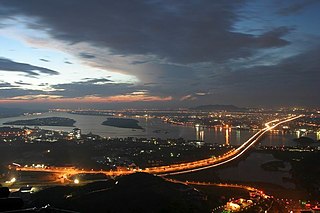
Shōnan (湘南) is the name of a region along the coast of Sagami Bay in Kanagawa Prefecture, central Japan. Centered on Sagami River, about 60 kilometers southwest of Tokyo, the Shōnan region stretches from Ninomiya in the west to Fujisawa in the east, including Ōiso, Hiratsuka, and Chigasaki. Because of the bay, the region benefits from a mild climate and long beaches covered with dark volcanic sand.

Dongting Lake is a large, shallow lake in northeastern Hunan Province, China. It is a flood basin of the Yangtze River, so its volume depends on the season. The provinces of Hubei and Hunan are named after their location relative to the lake: Hubei means "North of the Lake" and Hunan, "South of the Lake".

The Li River or Li Jiang is the name for the upper reaches of the Gui River in northeastern Guangxi, China. It is part of the Xijiang River system in the Pearl River basin, flowing 164 kilometres (102 mi) from Xing'an County to Pingle County.

The Lingqu is a canal in Xing'an County, near Guilin, in the northwestern corner of Guangxi, China.

The Xi River or Si-Kiang is the western tributary of the Pearl River in southern China. It is formed by the confluence of the Gui and Xun Rivers in Wuzhou, Guangxi. It originates from the eastern foot of the Maxiong Mountain in Qujing City, Yunnan Province. Then it flows east through Guangdong, and enters the Pearl River Delta just east of the Lingyang Gorge in Zhaoqing. The main branch of the Xi River flows southeast through the delta entering the South China Sea at Modao Men, just west of Macau. The major cities along the Xi include Wuzhou, Zhaoqing, and Jiangmen.

The Yuan River, also known by its Chinese name as the Yuanjiang, is one of the four largest rivers in Hunan province in southeast-central China. It is a tributary of Yangtze River. It is 864 kilometres (537 mi) long and rises in Guizhou province in the Miao Mountains near Duyun and is navigable. The upper stream is called the Longtou River, and downstream it is called the Qingshui or Ch‘ing-shui River. It becomes the Yuan River after its confluence with its northern tributary, the Wu River.

The Miluo River is located on the eastern bank of Dongting Lake, the largest tributary of the Xiang River in the northern Hunan Province. It is an important river in the Dongting Lake watershed, known as the location of the ritual suicide in 278 BC of Qu Yuan, a poet of Chu state during the Warring States period, in protest against the corruption of the era.

Yongzhou is a prefecture-level city in the south of Hunan province, People's Republic of China, located on the southern bank of the Xiang River, which is formed by the confluence of the Xiao and Xiang Rivers, and bordering Guangdong to the southeast and Guangxi to the southwest. With a history of 2000 years, Yongzhou is one of the four ancient counties in Hunan. Its total area is 22,255.31 square kilometres (8,592.82 sq mi), and at the 2020 Chinese census it had a total population of 5,289,824, of whom 1,146,692 lived in the built-up area made of the 2 urban districts.
The Nanling, also known as the Wuling, is a major mountain range in Southern China that separates the Pearl River Basin from the Yangtze Valley and serves as the dividing line between south and central subtropical zones. The main range of Nanling Mountains stretch west to east about 600 kilometers (370 mi) from Guilin and Hezhou of the eastern Guangxi to Ganzhou of the southern Jiangxi, north to south about 200 kilometres (120 mi) from Yongzhou and Chenzhou of the southern Hunan to Qingyuan and Shaoguan of the northern Guangdong; With its branches, the whole mountains run west to east 1,400 kilometers (870 mi).
Lanshan County is a county of Hunan Province, China, it is under the administration of Yongzhou prefecture-level City.

Jianghua is an autonomous county of Yao people in the Province of Hunan, China, it is under the administration of Yongzhou Prefecture-level City.

The Xiao River is the Main Stream of the upper Xiang River located in Yongzhou, Hunan. As of 2011 Water Census of China, it has a length of 365 kilometres (227 mi) from the headwaters to the confluence in the Ping Island of Yongzhou with the Xiang River West Branch originating from Guangxi. With the tributaries, its drainage basin area is 12,094 square kilometres (4,670 sq mi). Night rain on the Xiaoxiang, one of the Eight Views of Xiaoxiang, is located in this river.

Xiaoxiang, also transliterated XiaoXiang, Hsiao Hsiang, and Chiu Chiang, in some older sources, refers to the "lakes and rivers" region in south-central China south of the middle-reaches of the Yangtze River and corresponding, more or less, with Hunan province. Xiaoxiang is less a precise geographic entity than a concept. Xiaoxiang is used in the genre of Xiaoxiang poetry of Classical Chinese poetry and in literature for symbolic purposes, in part because this was a significant area, which at least through the Song dynastic era China was still considered a wild place full of malaria, barbarians, and wild beasts. Indeed, for much of early Chinese history, this area belonged not to China, but to the independent state of Chu. Beginning at least with Qu Yuan, in the third century BCE, this region came to symbolically represent the unjust exile of a talented minister or government official by an unappreciative king or emperor.

The Hunan–Guangxi railway or Xianggui railway, is a mostly electrified railroad in southern China that connects Hunan province and the Guangxi Zhuang Autonomous Region. The shortform name of the line, Xianggui, is named after the Chinese short names of Hunan, Xiang and Guangxi, Gui. The line runs 1,013 km (629 mi) from Hengyang in Hunan to Friendship Pass on Guangxi's border with Vietnam. Major cities along route include Hengyang, Yongzhou, Guilin, Liuzhou, Nanning, Pingxiang, and Friendship Pass.
The Chongling River, also known as Jiao River and Lingyuan River, is a right-bank tributary and one of the largest tributaries of the middle Xiang River in Hunan, China. The river rises in the Renxingling Mountains of Lanshan County. Its main stream runs generally south to north through Lansghan, Jiahe, Xintian, Xintian, Leiyang, Changning and Hengnan counties, and it joins the Xiang at Jiaohekou of Hengnan. The Chongling River has a length of 223 kilometres (139 mi), with its tributaries, and the drainage basin covers an area of 6,623 square kilometres (2,557 sq mi). The middle reaches of the river have been designated as a protected Ramsar site since 2022.
The Luhong River, also known as Ying River, is a left-bank tributary of the upper Xiang River in Yongzhou Prefecture, Hunan Province, China. Luhong River rises in Lishuichong of Dasheng Town in the east of the Huanghua Mountains, Dong'an County. The main stream of the Luhong River runs generally northwest to southeast, and it joins the Xiang at Shuijiangkou of Gaoxishi Town, Lengshuitan. The main stream of the Luhong River has a length of about 80 kilometres (50 mi), with its tributaries; the drainage basin covers an area of 1,076 square kilometres (415 sq mi).
The Haiyang Mountains, in ancient times known as "Yanghai Mountains" form a mountain range in the northeastern Guangxi separating West River drainage basin of the Xi River from the Xiang River drainage basin of the Yangtze River. The mountain range is located between Yuecheng Mountains and Dupang Mountains of Nanling Mountain Range, it is a major mountain range in Guilin, Guanxi, China. It runs south to north through Guanyang, Quanzhou, Xing'an, Lingchuan, Gongcheng and Yangshuo six counties. With a width of 35 kilometres (22 mi) to 40 kilometres (25 mi), the Haiyang Mountains stretch more than 97 kilometres (60 mi) from Yangshuo to Quanzhou. The highest peak is Baogai Hill (宝界岭) with an elevation of 1,935.8 metres (6,351 ft).

Ping Island is a river island with a general perimeter of about 600 metres (2,000 ft) and an area of 0.6 square kilometres (0.23 sq mi) in the middle north of Lingling District, Yongzhou, Hunan.
Xiangjiangyuan Yao Township is an ethnic township of the Yao people in Lanshan County, Hunan, China. It is the home of the Yao people and is named after the source of the Xiang River. The township covers an area of 149 square kilometres (58 sq mi). At the end of 2015, it had 742 resident families with a population of 3,188; the Yao people account for 95 percent of the population. The township is divided into five villages and part of the Jingzhu Forest Farm (荆竹林场). The seat of the township is at the village of Tongcun (桐村).

Hunan is a landlocked province situated in the Central China and central portion of Yangtze River, Hunan spans from 108°47′ to 114°15′ longitude and 24°39′ to 30°8′. Hunan shares land borders with Jiangxi to the east, Guangdong and Guangxi to the south, Guizhou to the west, Chongqing to the northwest, and Hubei to the north. Hunan is 667-kilometre (414 mi) from east to west, 774-kilometre (481 mi) from south to north, with a land area of 211,800-square-kilometre (81,800 sq mi), making it the 10th largest province in China. Hunan is ringed on three sides by mountains and hills, it looks like a horseshoe. Of Hunan's total area, 51.2% consists of hilly area, 13.9% consists of basin, 13.1% consists of plain, 15.4% consists of hills, 6.4% consists of water.















